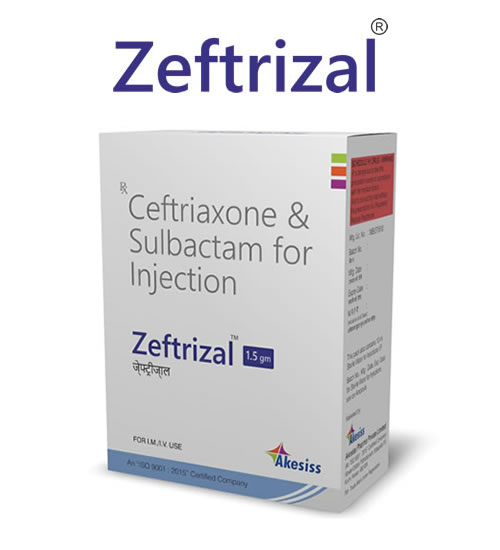COMPOSITION:
Each Vial contains:
Sterile Ceftriaxone Sodium IP eq. to Cerftriaxone ..…… 1000 mg
Sterile Sulbactum Sodium USP eq. Sulbactum ……….…… 500mg
DESCRIPTION:
The combination of Ceftriaxone (3rd generation Cephalosporin) and Sulbactam (beta-lactamase inhibitor) provides a solution for treatment of bacterial infections caused betalactam resistant pathogens.
Ceftriaxone has a broad spectrum of antibacterial activity which is beta-lactamase stable and exhibits excellent activity against Streptococcus pneumoniae, methicillin-susceptible staphylococci, Haemophilus influenzae, Moraxella catarrhalis and Neisseria sp. which are the most common cause of community acquired and hospital acquired infections.
Fantin et. al. in 1990, showed that the MIC and MBC of ceftriaxone was lowered by addition of sulbactam and the bacterial killing was enhanced proportionately.
Pharmacology:
The bactericidal activity of Zeftrizal is due to the Ceftriaxone component and the ability of Ceftriaxone to interfere with the biosynthesis of the peptidoglycan component of the bacterial cell wall by binding to and inactivating penicillin-binding proteins (PBPs).
Zeftrizal is active against all the organisms sensitive to Ceftriaxone. In addition it demonstrates synergistic activity (reduction in minimum inhibitory concentrations, for the combination versus those of each component) in a variety of resistant Gram-Negative Aerobes as well as Gram positive such as Acinetobacter calcoaceticus , Enterobacter aerogenes, Enterobacter cloacae, Escherichia coli, Haemophilus influenzae (including ampicillin-resistant and beta-lactamase producing strains), Haemophilus parainfluenzae, Klebsiella oxytoca, Klebsiella pneumonia, Moraxella catarrhalis (including beta-lactamase producing strains), Morganella morganii, Neisseria gonorrhoeae (including penicillinase – and nonpenicillinaseproducing strains), Neisseria meningitides, Proteus mirabilis, Proteus vulgaris, and Serratia marcescens.
Ceftriaxone is also active against many strains of Pseudomonas aeruginosa. Many strains of the above organisms that are resistant to other antibiotics, eg, penicillins, cephalosporins and aminoglycosides, are susceptible to Ceftriaxone.
Indication:
Meningitis
For treatment of Nosocomial infections surgical prophylaxis
Urinary tract infections (complicated by underlying urological abnormalities)
Skin and soft tissue infections Like cellulites, erysepalis etc.
Cholecystitis
Osteomyelitis
Sexually transmitted diseases (Gonorrhoea, Chancroid, Syphilis)
Chronic suppurative bacterial otitis media
Infections in dialysis unit
Safety & tolerability profile:
Clinical studies of the combination of sulbactam plus beta-lactam antibiotics or penicillins have revealed no major hematologic, renal, hepatic, or central nervous system reactions. Diarrhea has not been a major problem after intravenous use.
Incidence of side-effects due to Ceftriaxone is as follows: G.I. effects- 2-3%, cutaneous reactions 1-3%, haematological 1-2%, and miscellaneous 1.5-3%
Precautions:
Transient elevations of BUN and serum creatinine have been observed, at recommended doses, the nephrotoxic potential of ceftriaxone is same as other cephalosporins. Since Ceftriaxone is excreted both via renal and bile patients with renal failure normally require no adjustment in dosage when usual doses of Ceftriaxone are administered.
Dosage adjustments are not necessary in patients with hepatic dysfunction; however in patients with both renal failure and hepatic dysfunction, dosage should not exceed more than 2 g daily with close monitoring of serum concentrations.
DOSAGE AND ADMINISTRATION:
The usual adult daily dose (in terms of Ceftriaxone) is 1-2 grams given once a day (or in equally divided doses twice a day) depending on the type and severity of the infection. The total daily dose should not exceed 4 grams.
Dosage regimen for Zeftrizal (Ceftriaxone-Sulbactam) should be adjusted in patients with marked decrease in renal function (creatinine clearance of < 30ml/min) and to compensate for reduced clearance less than 15ml/min patient should receive a maximum of 500mg of Sulbactam every 12 hours(maximum dose 1 gram of Sulbactam)


